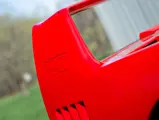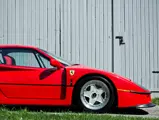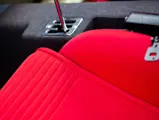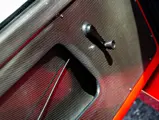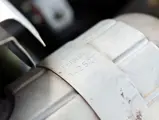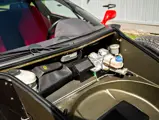Amelia Island 2021
1992 Ferrari F40
{{lr.item.text}}
$2,040,000 USD | Sold
 | Amelia Island, Florida
| Amelia Island, Florida
{{internetCurrentBid}}
{{internetTimeLeft}}

- A very desirable, late-production US-market example
- One of just 60 US-market examples produced for the 1992 model year
- Driven 3,304 miles at time of cataloguing
- Certified by Ferrari Classiche as a numbers-matching example retaining all of its major components
- The last Ferrari developed under Enzo Ferrari
To this day, the F40 remains one of Ferrari’s most captivating and impressively engineered supercars. Originally modeled from the superlative 288 GTO model to be an FIA Group B competitor, taking on the likes of the Porsche 959, the F40 continued forward even after the racing class was canceled. Rather than scrap the program entirely, Ferrari used the five initial 288 GTO Evoluzione examples as the basis of a new 40th-anniversary road car. It would be the last supercar devised under Enzo Ferrari’s stewardship.
The F40 chassis consequently featured a race-developed steel tube-frame chassis with four-wheel double-wishbone independent suspension, coil-over Koni shock absorbers, and four-caliper ventilated disc brakes. Leonardo Fioravanti’s coachwork design, which was aerodynamically perfected in Pininfarina’s wind tunnel, was built with paneling woven of Kevlar and carbon fiber, reducing the curb weight by approximately 20 percent, while simultaneously tripling the car’s structural rigidity. The twin-turbocharged V-8 was bored to displace 2.9 liters and equipped with IHI turbochargers and Behr intercoolers, and married to a five-speed gated-shifter transaxle. The resulting performance was stunning, with 478 horsepower and 425 pound-feet of torque capable of taking the F40 to 60 mph from standstill in 3.8 seconds and a top speed of 201 mph.
Cosmetically, the F40 amply reflected its basis in race-car development, with the low-weight body echoed by numerous interior considerations. Weight was further reduced with the use of cloth upholstery on plastic-composite racing seats, pull-strap door openers, drilled pedals, and Perspex windows.
Publicly introduced at the 1987 Frankfurt Motor Show, the F40 was initially earmarked for a low production run of 400 examples, but unexpected customer interest prompted Ferrari to ultimately build 1,315 cars. The commemorative supercar was initially only available in Europe, and early examples were built without catalytic converters or adjustable suspensions. In 1990, a more developed version began taking deliveries in the United States, standard-equipped with air-conditioning and catalytic converters. By the model’s production conclusion in summer 1992, just 213 examples had been specified and delivered to North America.
Occupying such an important position in Maranello’s supercar lineage, it is hardly surprising that many F40 examples were initially purchased by astute collectors and largely restricted to showroom viewing and concours exhibition. Relatively few cars were driven in anger on track,, but a handful of drivers were lucky enough to experience the F40 under such conditions. Case in point: Five-time Le Mans champion Derek Bell was allowed to push the car’s limits during a test drive for Classic & Sports Car magazine conducted during the mid-2000s.
His verdict: “It’s just magnificent…This is a car to make your hair curl. The power delivery is sensational, and I love the way the turbos come on with such a rush. Very quickly the situation changes from neutral understeer to amazing oversteer, but it’s all superbly predictable.”
CHASSIS 93103
Chassis 93103, offered here, is one of the last F40s built at Maranello. As one of just 60 examples constructed for the US market during the 1992 model year, it benefits from all the updates provided to the model since it was introduced in 1987. 93103 was assembled in February 1992 and delivered new in April 1992 to Ferrari of Houston, Texas clad in the standard F40 livery of Rosso Corsa over a Stoffa Vignona cockpit. On 8 April 1993, 93103 was sold to collector Herb Korthoff, of Park City, Utah; Korthoff is also recorded as having owned another F40 (92501) during this time. The car’s warranty card has been filled out by a “Sean Harris”—likely the son of Steve Harris, an authorized Ferrari dealer in Salt Lake City who also sourced 92501 for Korthoff. The car next appears in 2000 for sale at Shelton Ferrari of Fort Lauderdale, Florida, then showing 398 miles.
Derek Woods of Cape Coral, Florida purchased 93103 and later displayed the car at 13th Cavallino Classic in January 2004. 93013 reappears in 2010 under the care of Christopher Vecillio in West Palm Beach, Florida; Vecillio is believed to have purchased the car from Shelton Ferrari in 2008 then indicating approximately 2,800 miles. Vecillio displayed 93103 at the 19th Cavallino Classic in January 2010, where it scored over 97 points and earned a Platinum Award in the Supercar Class.
Invoices on file illustrate a regimen of meticulous care furnished to this F40 by each of its previous owners. 93103 has travelled under 40 miles since it was treated to a complete major service and belt service at Ferrari of Long Island in Plainview, New York. Executed in November of 2020, the car was also fitted with a new starter, alternator, horns, and four new tires. The consignor notes that the F40’s tires are bespoke to the model; the front and rear pair evidence different date stamps because Pirelli only makes them as needed, but both pairs are equally “as new.” 93103 also received an alignment, Pass Time tracking system, and rebuilds to its steering box and fuse panel. Earlier invoices illustrate regular servicing and fastidious attention paid to 93103 by Ferrari of Long Island and Ferrari of Fort Lauderdale.
Now showing 3,304 miles at time of cataloguing, this very-late production F40 is accompanied by its proper US manuals, tools, two keys, Ferrari Classiche Red Book circa 2010, and service invoices dating back to the mid-1990s.
Despite being the first installment in a long line of commemorative models that includes the F50, the Enzo, and the LaFerrari, the F40 continues to hold a special place in the heart of Maranello enthusiasts, bearing a close relationship to FIA race cars while having been supervised by Enzo Ferrari himself. Often occupying a crowning position in marque-focused collections, the F40 has evolved into one of Ferrari’s most celebrated supercars, revered by Maranello purists and hypercar aficionados alike. This low mileage, late-production US-market example is undoubtedly one of the most desirable examples ever brought to market.


















